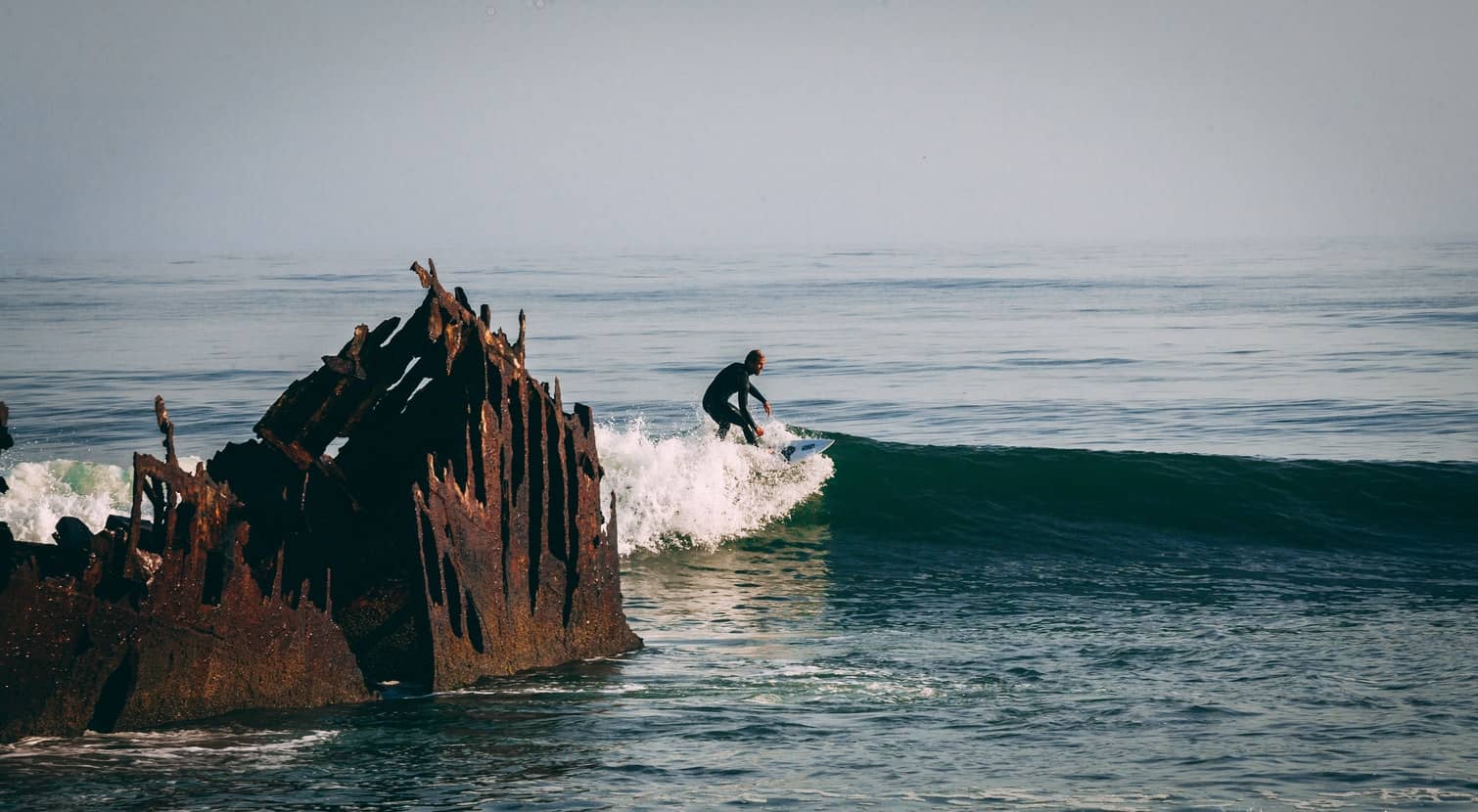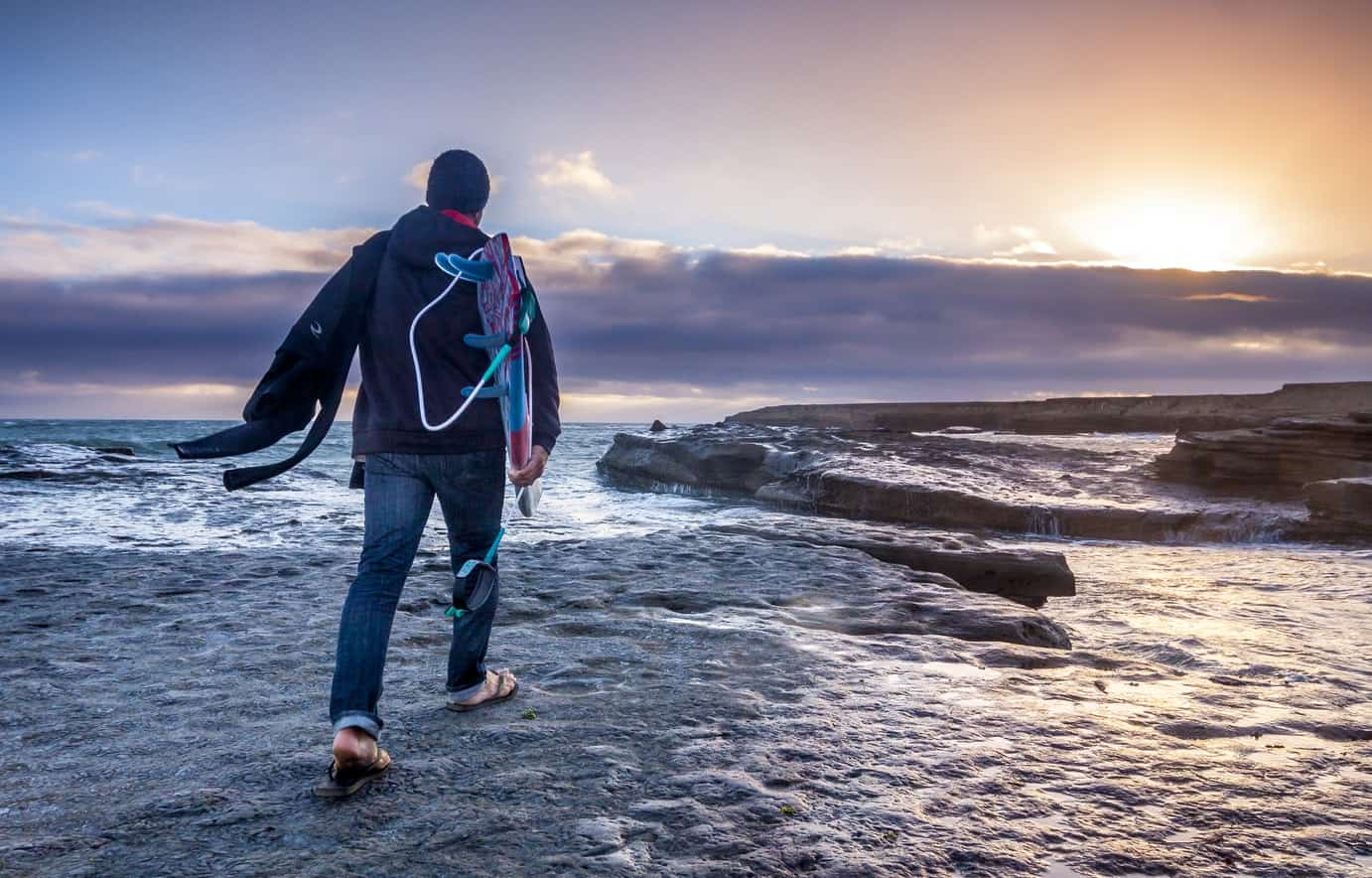Surfing has become popular because of the way it makes one feel. Riding a wave is transcendent; there is nothing in the world quite like the surfing experience. It is bliss and perfection all in one. People of all ages are taking surfing lessons, buying surfing gear, and heading to the beach. Surfing is no longer only for the young.
Is it possible to learn to surf in your 30s? Yes, men and women in their 30s can learn to surf, providing they are in great physical shape and don’t have any underlying illnesses that make it impossible to surf.
Only a small part of the surfing experience is wave-riding. It’s estimated that 90% of the time we spend in the water, we are paddling towards the wave, or swimming away from them.
What Muscles Are Used When You Surf?
As we said, most of the time, you’ll be paddling and preparing to ride a wave. Just when you’re about to ride, you push your body up from a prone position on the surfboard, to standing on the board, your arms extended as the wave starts to pull the surfboard along with it.
Paddling requires upper body strength, particularly in the arms, shoulders, the muscles of the neck, the chest muscles, and the muscles of your core. These muscles are as follows:
- Biceps: The muscles of your arm that bulge when you flex it.
- Triceps: Muscles on the outer part of the upper arm. These are necessary for paddling faster.
- Semispinalis Capitis and Splenius Capitis Muscles: These muscles are located at the back of the neck. You move your head up and down as you paddle, and these muscles are key for this purpose.
- Deltoids muscles: These shoulder muscles are used specifically for the rowing motion of the arms when paddling.
- Pectorals: These upper chest muscles flex when you are paddling.
- Trapezius Muscle Group: These muscles enable the arms and shoulders to rotate. Baseball pitchers exercise the trapezius to strengthen their overhead pitching motion.
- Latissimus Dorsi Muscles: Located on the sides of the upper back, the triangular-shaped “lats” are critical for swimming. Well-developed lats enable swimmers and surfing paddlers to move faster in the water, which is key for timing an oncoming wave you want to ride.
- Abdominal Obliques: These muscles are key for the rotation of the trunk and are located on either side of the body. They are critical muscles used in swimming and paddling.
How Can A Person In Their 30’s Build Up Surfing Muscles?
It is possible to learn to surf in your 30s if you keep yourself in good shape. Surfing involves constant movement and the muscles under the skin constantly flex, extend, and contract.
Good muscle tone means you’ll have more stamina in the ocean. More energy means having more fun. Nothing is so disappointing as running out of steam as you approach the wave you’ve been waiting for all day. You can surf if you’re out of shape, but you won’t enjoy it as much.
Every age group should do some exercise regularly to keep in shape for surfing. Here are some perfect exercises to prepare you to go out for hours at a time and riding one wave after the other.
- Ride a Bike: For strength and endurance, you want to get your cardiovascular system in top running condition. When paddling, the heart beats faster than normal because you are trying to paddle fast enough to get to the wave at just the right time.
Riding a bike not only gets your heart pumping, but it gets your legs in shape for kicking while paddling. Strong leg muscles come to the aid of the arms that paddle and help you move a lot faster on the surfboard.
- Swimming: There is perhaps no better exercise you can do to prepare to surf than swimming. You can swim in a pool, or you can swim in the ocean parallel to the shore.
When you paddle on your surfboard, your arms move over your head and then into the water. Your hands move the water away by cupping it and pushing it behind you.
At the same time, your legs kick so that the effort of your upper body is helped along by your legs and core.
Swimming builds strength and endurance and is one of the best ways to get into great condition to surf. Swimming freestyle is similar to paddling. All the muscle groups mentioned above get toned and conditioned when you swim.
When you’re not at the beach surfing, get a gym membership to a club that has a swimming pool. They are usually Olympic sized, which is 75 feet in length. Nothing builds endurance better than swimming the full length of large pools like these.
If you keep at it, you’ll be ready to surf for hours. Besides, swimming is one of the most enjoyable activities we can do for exercise. The water’s resistance is different from free weights, but it’s still the same as weight lifting. Swimming doesn’t build muscle mass like weight lifting does, because, in the water, muscle is heavier than fat.

However, you can build incredibly high levels of stamina by swimming a lot as your body becomes stronger and stronger.
- Rowing: Rowing is a great cardiovascular exercise like swimming, except you are outside the water. Rowing builds up the muscles of the arms and shoulders. In particular, rowing builds bicep muscles, triceps, trapezius, deltoids, and lats. If you have access to a rowboat with oars, it’s a great idea to row regularly.
- Running or Jogging: Both running and jogging are great cardio exercises. You don’t have to run at top speed. As long as you get the heart pumping fast for a few minutes, you’re doing wonders for your body and mind. Jogging and running both release endorphins, providing a sense of well-being while you increase stamina and endurance.
- Jumping Rope: Invest a few bucks in a jump rope, and you’ll be increasing your endurance as your heart pumps at a higher rate for a long period.
- Plank Exercises: “Plank Pose” uses your own body as resistance Plan pose involves remaining in one position for long periods without moving, as your body gets heavier.
Plank exercises strengthen the muscles in your back, abdominals, core muscles, neck chest, and shoulders. It also helps improve posture and helps build the resistance you need on the waves and when paddling.
- Hiking: Hiking up a mountain forces the heart to work harder. While you are climbing over a rock on the path, changing directions, and working against the steepness of the climb, you test your body’s endurance. You breathe the fresh mountain air and clear your lungs while the muscles of your legs and lower back get stronger.
Are There Surfing Lessons Especially For People In Their 30s?
Surfing instructors teach anyone who wants to surf, no matter what their age. When you make the decision that you want to learn to surf, find an instructor. He will likely offer you one-on-one instruction.
Group surfing lessons are normally given to people age 21 and under. Surf enthusiasts over 21 will want to have individual lessons.
You will learn how to paddle, what surfboard is the best for you, when to wear a wetsuit, how to swim past a rip current, and more. You’ll start to surf on whitewater, waves that are smaller than the typical surfing wave.
It is best at any age to take surfing lessons rather than trying to teach yourself. Only a few lessons may be needed until you’re ready to go out on your own. The learning curve is much sharper because surf instructors have experienced surfers themselves and can share their experiences on the water with you.
Related Questions
How Do I Know When It Is A Good Day For Surfing?
The best days for surfing are when the sun is out, and the wind is calm. Winds have an impact on waves and can make them too rough to ride, as well as dangerous.
You can check with your local weather service, who in turn gets the forecast for surfing from the National Weather Service. You can also check the times for high and low tides through your local weather service.
Lifeguards are great sources of information about ocean conditions on any given day. A lifeguard can tell you if there are strong rip currents or if the tides that day are conducive for surfing. Lifeguards will also tell you if there are groups of jellyfish in the area. These are days you’ll want to avoid going into the ocean. Jellyfish stings hurt a great deal and can take you out of the game if it’s a bad sting.
What Do I Do If I’m Caught In A Rip Current?
First of all, stay calm. You will get out of a rip current if you focus on what you have to do. It is very simple.
Swim parallel to the shore along the length of the rip current. When you reach its end (you can tell you’re at the end when there’s little or no pull away from the shore), reverse yourself and swim in the opposite direction to the other end of the current, moving in a little closer to the beach. Keep reversing course from one side to the other, moving in closer each time until you’re out of the current. Then swim in a straight line to the beach.
Are There A Lot Of People Learning To Surf In Their 30s?
More than ever before, people of all ages are starting to surf for the first time. It’s never too late to start. Some professional surfers began in their 40s and 50s, and they compete professionally in their 60s.
Your age has nothing to do with it. You can surf at age 30. You are still young throughout your 30s anyway. As long as you keep in shape, you can surf safely and enjoy the awesomeness of surfing beyond retirement!

